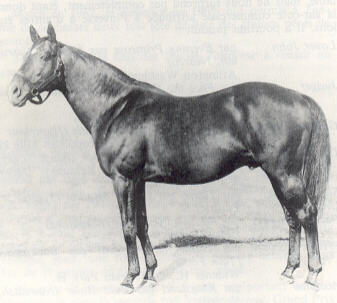
It is normal for a stallion to be syndicated today, but that was not the case in 1925 when Arthur B. Hancock, William Woodward, Marshall Field, and Robert Fairburn teamed up to purchase a French stallion by the name of Sir Gallahad. It was a bold move that not only ushered in the desirable Teddy bloodlines, but also ushered in an era of stallion syndication.
Pedigree Overview:
Sir Gallahad was born at Haras de Fitz-James in France in 1920. He was the product of a mating between Plucky Liege and Teddy orchestrated by breeder Jefferson Davis Cohen. Cohen had previously purchased Plucky Liege from her breeder Lord Michelham for whom he had served as secretary.
Plucky Liege had a beautiful pedigree herself (by Spearmint out of the St. Simon mare Concertina) and showed promise as a juvenile, even winning the five-furlong Great Sapling Plate in 1914. However, she was unable to keep her speed after her juvenile season.
Jefferson Davis Cohen had also purchased Sir Gallahd’s sire Teddy for 5,400 francs as a yearling. Teddy would have better racing luck than Plucky Liege, winning six races from 1916-17. Though his career was disrupted by World War I, historians rate him as the Champion Three-Year Old Colt of 1916 in both France and Spain.
According to American Classic Pedigrees, Teddy would go on to become an influential stallion in both Europe and the United States. He was the leading sire in France in 1923 and was in the top ten of the general sire list on eight other occasions.
Plucky Liege was first bred to Teddy in 1918, a mating from which she foaled Marguerite de Valois in 1919. Marguerite de Valois won four races in France and was stakes placed. Plucky Liege’s second mating to Teddy would produce Sir Gallahad. Plucky Liege would foal Bull Dog by Teddy seven years later, who too went on to become a leading sire in the United States.
Racing Career:
Sir Gallahad had a successful racing career that spanned from 1922-1924. He ran twenty-four times for trainer Robert Denman, winning eleven of those starts. Many of those victories came in stakes company, in which he was able to compete successfully in each year he raced. Sir Gallahad was able to win at both shorter and longer distances, but was never able to win at distances longer than 1 ¼ miles.
Perhaps one of the most memorable moments of Sir Gallhad’s career came at a time in which he didn’t race at all. Prior to the start of the 15-furlong Grand Prix de Paris, Sir Gallahad jumped off at a false-start, dumped his jockey, and plunged into the infield lake.
Sir Gallahad developed a sort of rivalry with a colt named Epinard while racing. Epinard was often referred to as the French “wonder horse” of his period. A 6 ½ furlong match race was set between the two horses, which Sir Gallahad won by a desperate neck.
Epinard was eventually shipped to the United States to race and went to stand at Kentucky’s Dixiana Stud in 1925. According to Thoroughbred Heritage, Claiborne Farm’s Arthur Hancock recognized that Sir Gallahad had defeated Epinard and could also be a very desirable stud in the United States.
Sir Gallahad Comes to America:
Arhtur Hancock gathered three other men – William Woodward, Marshall Field, and Robert Fairburn – and approached Sir Gallahad’s owner and breeder Jefferson Davis Cohen. At the time, Teddy had already become a leading sire in Europe and Plucky Liege was continuing to produce winners. Plus, Sir Gallahad had already stood one season for Cohen. Because Cohen still owned both Teddy and Plucky Liege, he was more than willing to part with Sir Gallahad for the hefty price of $125,000.
The deal was made and Sir Gallahad made his trek overseas by boat. Officially registered as Sir Gallahad III in the United States, he stood his first season at Claiborne Farm in 1926. Sir Gallahad received a lot of attention from breeders without his sire Teddy nearby to take all the good mares. He would immediately be successful at Claiborne, with 1930 Triple Crown winner Gallant Fox hailing from his first crop. Gallant Fox later sired 1935 Triple Crown winner Omaha.
Thoroughbred Heritage notes that Sir Gallahad represented a turning point in which the American breeders moved away from the lanky, stayer-type of Thoroughbred towards a speed model. Sir Gallahad was a lengthy and well-muscled horse with a good shoulder and hip. Despite some unsoundness in his pedigree, Sir Gallahad also possessed sound legs and feet.
Sir Gallahad was the leading sire in 1930, 1933, 1934, and 1940. He was so good as a broodmare sire that he led the broodmare sire list on a record-setting twelve occasions: 1939, 1943-1952, and 1955. He sired a total of 567 foals. 336 of those foals would be winners and 64 would become stakes winners.
His Kentucky Derby winning sons Gallant Fox (1930), Gallahodian (1940), and Hoop Jr. (1946) made him one of just four stallions to sire three Kentucky Derby winners. He additionally produced Preakness Stakes winner High Quest and Champion filly Vagrancy. Sir Gallahad was a remarkably fertile stallion and was bred up until he was twenty-nine years old in 1949, though he sired just 11 foals in his final crop. He was found dead in his paddock on July 8, 1949 and was buried in Claiborne Farm’s Marchmont cemetery, right next to Marguerite (though a gravestone rests in Claiborne’s main cemetery). Marguerite was the dam of his best son, Gallant Fox, and his full-siblings Fighting Fox and Foxborough.
Sir Gallahad is highly regarded as one of the sport’s most important stallions. Not only did he produce some of racing’s most notable names as both a sire and broodmare sire, but he also helped put Claiborne Farm on the map and ushered in the modern era of stallion syndication that we often see today. For that, he will be forever remembered and respected.



